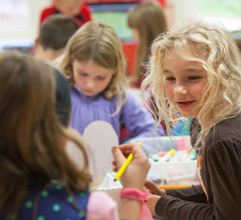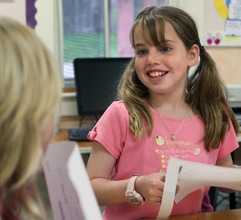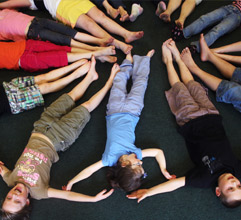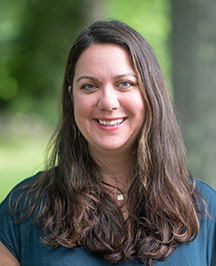Second Grade




Kari Allen
Second Grade Teacher
SBS Class of 1998
Smith College, BA
Plymouth State Univ., MEd
NH Elem. Ed. Cert.
In second grade, we have three main goals that we live by: Respect Yourself, Respect Others, and Respect the Environment. We are a community of learners, and we recognize that each of us has different strengths and weaknesses. Each student is responsible to do his/her best, take responsibility for his/her learning, and help a classmate in need.
Morning Meeting is a time when we go over the schedule for the day, share exciting news and participate in a short greeting activity. It is a chance for the class to gather as a group, learn to listen to and respect the ideas of others, and build a group identity as second graders.
Each day we spend more than two class periods on balanced literacy, a term used to describe a well-rounded approach to the teaching of reading, writing, spelling, grammar, speaking and listening skills.
We use a Reading Workshop approach which includes Independent Reading, Guided Reading, Shared Reading, Literature Circles and Read Aloud. Students are assessed throughout the year to determine their current instructional reading level; instruction for each child is then based upon books appropriate for that level. Students read a variety of books in many genres, some of which may relate to other curricular areas. They read independently (silent reading of self-selected books) and in small Guided Reading groups where there is direct instruction from the teacher. At other times the teacher reads aloud to the class, often modeling comprehension skills. Students are expected to spend 15 minutes reading at home each night.
Instruction in spelling, phonics and vocabulary is based on each student’s developmental level of spelling and word knowledge. Each student is assessed several times during the year to ï¬nd his/her current spelling ability and progress. Lessons focus on spelling strategies, memorizing high-frequency words, word patterns, syllables, afï¬xes and derivations. Students learn to use a variety of resources, including spelling dictionaries and an ongoing class Word Wall, to edit and self-correct spelling in their written work. This is supplemented with vocabulary study of subject area key words. Students participate in a wide variety of activities to broaden their awareness of high-frequency words, spelling patterns, rhymes and word derivations. Our word study program is based on resources such as Rebecca Sitton’s Spelling Program, Words Their Way and Phonics Lessons by Fountas and Pinnell.
We do writing across the curriculum in second grade; students are expected to do written work in math, reading, social studies and science in addition to Writing Workshop, our extended writing block. In the first unit of study, Launching the Writing Workshop, students review the stages of the writing process and the routines we use to develop our writing. We complete several units of study during the year, including: Narrative Writing, Using Authors as Mentors, Writing and Revising Realistic Fiction, and Writing to Grow Ideas. Students also “make” books where they can write and illustrate simultaneously.
For Math, we use the Investigations in Number, Data and Space curriculum developed by TERC of Cambridge, MA. This program takes a hands-on approach that encourages exploration, questioning and sharing. The children are frequently asked to share their thinking and strategies. Students use materials like snap cubes, pattern blocks, geoblocks, connecting cubes and counters to help them in their problem solving. Through playing a variety of math games, both at school and at home, students apply and strengthen many of the basic math facts and concepts introduced during math class. Some of the topics we study are: numbers and routines, addition and subtraction facts, place value, money, 2D and 3D shapes, geometry, patterns and rules, fractions, measurement, problem solving skills and mental math. Whenever possible, we introduce children’s literature that helps to highlight the math topic. Students also use the Reflex Math website to develop their math fluency with the addition and subtraction facts which they are encouraged to master during second grade.
In Science and Social Studies, students learn about a number of topics including: Rocks, Sand and Soil; Animals; the Wampanoag People and the First Thanksgiving; and Life Long Ago. The curriculum provides hands-on, heads-on and hearts-on learning and emphasizes activities that engage students in inquiry and problem solving about important issues in the world. Students are introduced to research skills including reading for information, note-taking, and organizing and presenting information. Students learn to write about what they learn in Science and Social Studies as they record observations, draw sketches, attach samples and take notes.
In Spanish class, the goal is to create situations where the vocabulary is contextualized. As students are exposed to the language, they move from being able to recognize a word and to react to it, to being able to use it in a given situation. The main tool to contextualize language is through stories created in class using a lot of visual support. Songs and games also play an important role. The focus this year is on reinforcing and expanding the following areas: greetings, colors, numbers (0-39), body parts, emotions, clothing, common objects at school and at home, animals and family vocabulary, extended family, foods and action words. On the cultural side, we celebrate Las Posadas and the three Wise Men, common celebrations to Mexico and many other Latin-American countries.
In Art, we continue to learn about basic elements and principles such as line, shape, color, texture, form, composition and pattern. Students explore a variety of art materials, including oil pastels, crayons, pencils, watercolor and acrylic paint, to create artwork both from observation and from their imagination. Second graders also learn simple printmaking techniques and use sculpting materials such as beeswax, clay, papier mâché and recycled items. Many of our art projects are integrated with Science and Social Studies curriculum. In addition students are introduced to several famous master artists and learn about their artistic styles and subject matter. Students have many opportunities to share their own ideas and artwork with classmates and contribute to class discussions.
In Music class, we integrate several elements to develop musicianship and social growth, and build on what children do naturally: sing and play. Class includes group singing, movement games and stories, rhythmic speech and movement, work with un-pitched and tuned percussion instruments, and dramatic play. In second grade we introduce music notation and begin to build a vocabulary of musical concepts and terms.
In Health Education class, the main topics covered are: food groups, the life cycle, personal safety, rules and laws within the community, bones and muscles of the body, and types of physical activity. We also address social and emotional health by exploring topics such as cooperation with others, working through conflict, and learning how to be a good friend. The Health Education program has been developed in accordance with guidelines of the State of New Hampshire Health Education Standards and the National Health Education Standards.
The goals of Physical Education are to expose children to a variety of activities, games and sports; to teach teamwork and friendly competition; to encourage students to give their best; to let them experience a variety of activities so that they can enjoy and be physically fit for a lifetime. The classes encourage and enable all students to have experiences of success and good sportsmanship.
During our STEAMS blocks, students have the opportunity to rotate to various centers and engage in activities such as technology, writing, math, science, cooking, building, art, drama, and listening. There is time at the end of each class for reflection on these activities and sharing what was learned.
